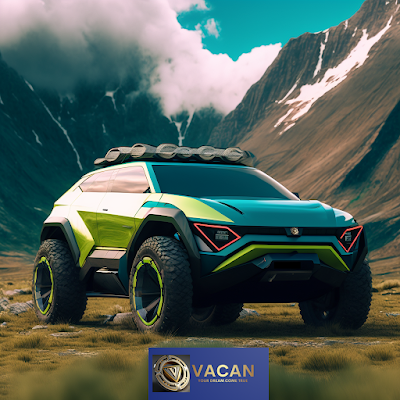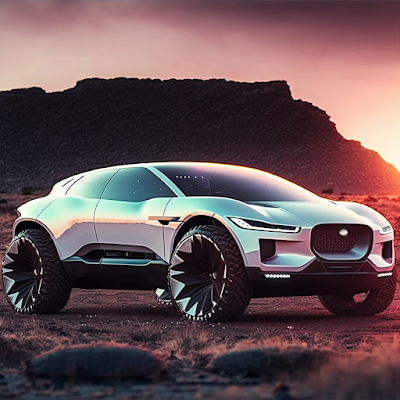Vacan Motors: Revolutionizing Electric Vehicle Design and
Ownership Through NFTs
Since 2005, I have been dedicated to designing a uniquely
Ecuadorian electric vehicle. Over nearly two decades, I’ve conceptualized not
only the vehicle design, but also developed innovations in electric motors,
batteries, and more, culminating in the most advanced vehicle blueprint to
date. Our project now combines cutting-edge design with the latest technology,
aiming to create exclusive vehicles through NFTs that fund and propel our
vision forward.
Our Vision and Strategy
Our goal is to harness the transformative power of electric
vehicles (EVs) and artificial intelligence (AI) to reshape the auto industry
and revolutionize vehicle ownership. To achieve this, we’ll leverage NFT
technology, where each NFT represents a unique vehicle design that can be
brought to life. These NFTs serve as digital patents, providing buyers not only
with exclusive ownership but also the option to realize their investment
through the physical production of their design.
NFT-Driven Ownership Model
With over 3,000 unique designs—2,000 for vehicles, 500 for
boats, and 500 for drones—each NFT represents an innovative model. Prices range
from one to forty ethers, and proceeds will fund research, development, and the
initial production of three flagship vehicles. When owners reach specific
investment thresholds, we’ll initiate manufacturing, enabling them to own a
one-of-a-kind vehicle based on their NFT.
Strategic Partnerships and Production
To ensure global serviceability and reliability, we’re
exploring partnerships with leading EV manufacturers like BYD, Ford, and GM.
These collaborations will allow us to utilize existing infrastructure for
assembly and maintenance, ensuring each vehicle has access to service
worldwide. BYD, with its expertise in EVs and manufacturing, is our primary
partner, while Ford’s idle assembly plants offer a potential U.S. production
base. This approach significantly reduces production costs by leveraging existing
components (e.g., chassis, engines, batteries) while ensuring our unique
designs are seamlessly integrated with robust EV technology.
Our NFTs go beyond digital art—they are patents for
high-value, functional assets. Each NFT is designed to be financially
rewarding: NFT owners could receive royalties for each model produced based on
their design. By purchasing one of our NFTs, buyers not only acquire exclusive
ownership rights but also become investors in the development of a
groundbreaking EV.
Our vehicles will eventually incorporate our proprietary
innovations:
Nanocell-Enhanced Electric Motors: Permanent magnet motors
using nanocells for increased power and efficiency.
Nanocell Battery Technology: Liquid metal batteries capable
of tripling the range of standard EVs.
Self-Recharging Turbines: Turbines that automatically
recharge batteries, minimizing recharging needs to just twice a year.
These patented technologies will elevate our vehicles beyond
existing options, offering superior durability, range, and sustainability.
Establishing Manufacturing Plants
To meet demand and reduce dependence on external facilities,
we plan to build our own manufacturing plants in Virginia, USA, and Imbabura, Ecuador. The choice of Ecuador, a dollarized economy, provides currency stability for trade. Partnering with BYD or another major manufacturer will enable us to set up a fully operational, high-tech assembly plant, positioning Ecuador as a leader in EV production in South America.
Financial Viability and Market Impact
Auto manufacturing is capital-intensive, with world-class
facilities costing approximately $8 billion. By partnering with established
manufacturers and leveraging their existing assembly lines, we’ll reduce
initial research and development costs. The economic benefits will extend to job creation and other sectors, supporting Ecuador’s industrial and
technological development.
A New Era of Real-World NFTs
Unlike speculative digital assets, our NFTs bring intrinsic
value through functional, customizable designs that may one day drive on the road. Each NFT purchase supports the production of these vehicles, allowing owners to realize a dream car that reflects their unique vision. For designs intended for road use, our models will comply with international safety standards, ensuring they are road-ready worldwide.
Join Us in Making History
We’re pioneering an industry where NFTs provide tangible
returns. Whether you’re a collector, investor, or auto enthusiast, our NFTs
offer an opportunity to own a part of automotive history. The future of
personalized EVs begins here, and we invite you to invest in an NFT that could become the world’s next iconic vehicle.
This detailed breakdown highlights the significant
challenges and costs involved in establishing an automobile manufacturing
plant. For Ecuador, or any other country aiming to enter the automotive
industry, it is essential to account for several factors:
1. Research and Development (R&D)
R&D accounts for a substantial portion (at least 16%) of
the total cost of building an automotive manufacturing plant. This includes the
development of new technologies, designs, and systems that keep the company
competitive in the global market.
2. Land and Infrastructure
A factory requires large amounts of land (200-300 hectares)
for construction, with costs potentially reaching billions of dollars. Ecuador
would need to ensure the availability of land in strategic locations like
Yachay, with the necessary infrastructure to support manufacturing, logistics,
and distribution.
3. Labor Costs
Labor costs are a significant portion of the overall
expenses. Ecuador would need to invest in workforce training and management to
minimize turnover and absenteeism, which could increase operational costs.
4. Maintenance and Operating Costs
A new plant will require substantial investment in maintenance and daily operations. Maintenance costs could range between $500 million and $1 billion annually.
5. Design and Construction
The cost to design and construct a car manufacturing plant
can be very high. For instance, Tesla’s Gigafactory cost $5 billion, with half
of that going toward design. The plant must integrate effectively with
surrounding infrastructure, which adds to the cost.
6. Equipment and Materials
Equipment and raw materials for manufacturing are a major
investment. This includes machinery, metals, and construction materials, which
could amount to billions of dollars. Collaboration with Latin American
companies, such as those in Chile, Bolivia, and Peru, would be essential to
source materials and equipment.
7. Packaging and Logistics Costs
Packaging and logistics, including transportation and energy
costs, are important to consider in the long-term operational plan. The plant’s
location will play a role in minimizing these costs, especially if it can
access nearby distribution channels.
8. Environmental Costs and Regulations
Green technologies and compliance with environmental
regulations could incur significant costs. Building energy-efficient plants and
reducing emissions are essential investments to align with global standards and
sustainability goals.
9. Sales Tax and Legal Framework
The current VAT tax structure in Ecuador could pose a
barrier to foreign investment in the automotive industry. A reduced VAT, along
with reforms in the permitting process, would make the country more attractive
to global manufacturers.
10. Advertising and Market Penetration
Building brand recognition and advertising products globally
are crucial to a new car company’s success. Significant marketing expenditures
are needed to ensure that the product reaches consumers effectively.
11. Time to Build
Depending on the site location and available resources,
building an automobile manufacturing plant can take anywhere from one to three
years. However, bureaucratic delays in Ecuador could extend this timeline.
Final Thoughts:
For Ecuador to successfully establish an automotive
manufacturing plant, it needs comprehensive strategic planning to address these
costs and barriers. Additionally, it must work on creating an enabling
environment for foreign investments, including reforming its tax laws,
improving the efficiency of permitting processes, and fostering regional
cooperation in sourcing materials and parts. Forming a South American
consortium to pool resources and knowledge would also strengthen Ecuador’s
position as a potential manufacturing hub.
This analysis offers a roadmap for what Ecuador must
consider when setting up an automobile manufacturing industry. With the right
approach, it is possible to overcome these challenges and build a competitive
industry that could contribute to economic growth, technological advancement,
and regional integration.
.jpg)







No hay comentarios:
Publicar un comentario